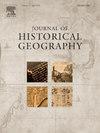Signs related to the safety of navigation on late medieval and early modern nautical charts of the Adriatic Sea, circa 1270 - 1824
IF 1.3
2区 历史学
Q2 GEOGRAPHY
引用次数: 0
Abstract
The Adriatic Sea, a vital component of the Mediterranean's interconnected navigational network, shares developmental challenges common to the broader Mediterranean region. This region's rich maritime navigation tradition, spanning millennia, renders it particularly relevant to the study of maritime cartography. This research meticulously examines a collection of 79 manuscript and printed nautical charts depicting the Adriatic Sea. The primary objectives of this study were multifaceted: to catalogue all signs related to the safety of navigation on these charts, to elucidate their meanings, to trace the timeline of their initial and subsequent appearances, and to assess the extent of their standardization. The analysis reveals that the signs representing rocks, rocks awash and shoals exhibited a prolonged period before reaching a standardised form. In contrast, the sign for anchorage maintained its original form indicating a consistency in its representation and perceived utility. A notable finding of this study is the temporal discrepancy in the appearance of certain signs on the Adriatic Sea charts compared to their emergence in other European seas, and that the signs did not always develop in a progressive manner. Signs depicting shoals, rocks and rocks awash alerted navigators to potential hazards, while signs denoting safe anchorages and depths provided essential navigational assistance. These insights contribute significantly to the broader understanding the change, progression and standardisation of nautical chart signs over time. This study sheds light on the intricate relationship between cartographic representations and cartographic signs, underscoring the pivotal role of these signs in historical and contemporary navigation.
求助全文
约1分钟内获得全文
求助全文
来源期刊

Journal of Historical Geography
Multiple-
CiteScore
1.50
自引率
10.00%
发文量
53
期刊介绍:
A well-established international quarterly, the Journal of Historical Geography publishes articles on all aspects of historical geography and cognate fields, including environmental history. As well as publishing original research papers of interest to a wide international and interdisciplinary readership, the journal encourages lively discussion of methodological and conceptual issues and debates over new challenges facing researchers in the field. Each issue includes a substantial book review section.
 求助内容:
求助内容: 应助结果提醒方式:
应助结果提醒方式:


